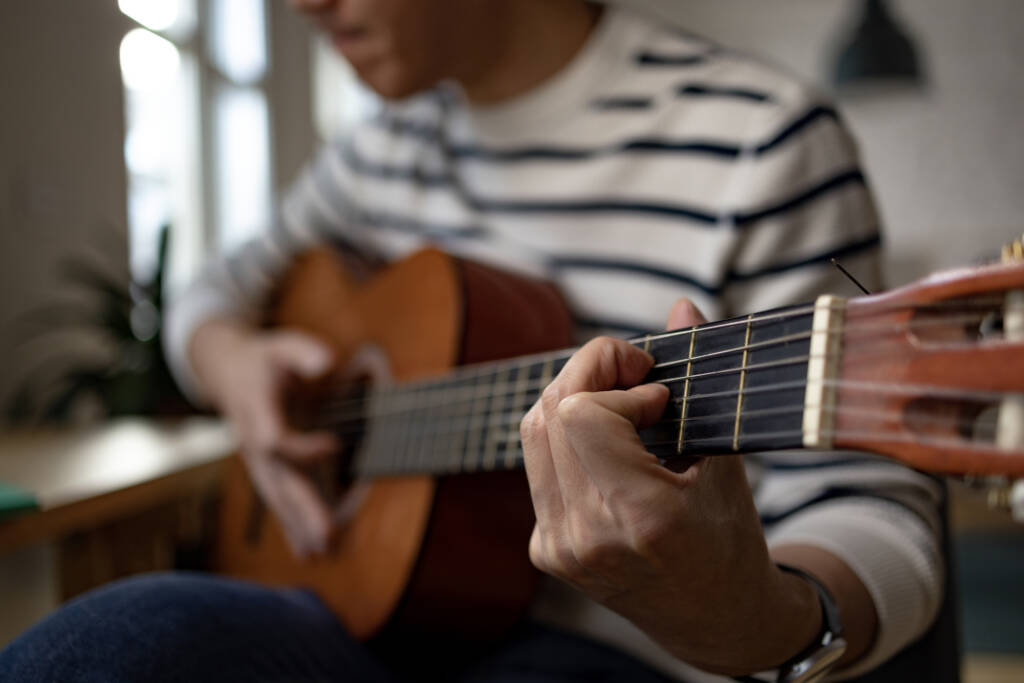
Ukulele 1a

If you’ve ever dreamed of learning to play the ukulele, this is your chance. Whether you want to play the ukulele for your family and friends, desire to be a professional performer, or just love playing music, this course is a great place to start. No prior music experience is needed. You will learn the fundamentals of music and the basic skills necessary to play a wide variety of music styles. Your guide will take you through each step of this journey towards becoming a skilled ukulele player and musician. This course can be used as a performing/fine arts credit to meet the art requirement for high school graduation.
Major Topics and Concepts
• Time in music: beat, rhythm, and meter
• Sound in music: pitch, dynamics, duration, and timbre
• Melody and harmony
• Exploring the ukulele and its parts
• Ukulele care and maintenance
• Holding the ukulele (standing and seated positions)
• String Names
• Tuning the ukulele: electronic tuner (including phone apps), tuning to
match a pitch
• Right-hand finger names
• Using a pick
• Using the right-hand fingers: strums, free strokes, and rest strokes
• Keeping a steady beat
• Making a music video
• Practice area and tools
• The Five Practice Principles
• Concentration development
• Mistakes during a performance
• Left-hand fingering and form
• How to play “Four-Finger Workout”
• Reading ukulele tablature
• How to play “Happy Birthday to You”
• How to play “Spider Crawl Jam”
• Chord diagrams
• Am-D7 chord progression
• How to play “Blues for Two”
• Alternate chord fingering
• Practicing with hands separately
• Improvising: creating a ukulele solo
• How to play “Spanish Rock”
• How to play “Spanish Song”
• Chord quality: A minor (Am), A major (A), and A dominant seventh (A7)
chords
• Common fingers
• How to play “Island Breeze”
• Ear Training: Chord quality
• Responding to chord qualities
• F-C7 chord progression
• How to play “Where Has My Little Dog Gone?”
• Ear Training: F-C7
• C-G7 chord progression
• How to play “London Bridge”
• Ear Training: C-G7
• F-Dm chord progression
• How to play “Nēnē”
• Ear Training: F-Dm
• The music staff
• Exploring the treble clef
• Notating time and sound in music
• First note C
• Reading Music: Basic rhythm patterns
• New note D
• How to play “CD Blues”
• Ear Training: Melodies
• New note E
• How to play “au clair de la lune”
• How to play “Hot Cross Buns”
• How to play “Merrily We Roll Along”
• Comparing standard music notation and tablature (TAB)
Course Materials
You will need a playable ukulele (soprano, concert, or tenor) and a way to
record and submit a video performance to your instructor. Because of the
differences in tuning, baritone and bass ukuleles are not appropriate for this
course.
A ukulele is “playable” if it is the correct size for the ukulele player, is easy
to press the strings down against the frets, and plays in tune up and down
the fretboard. There are three common types of ukuleles: soprano, concert,
or tenor. If you do not already have a ukulele, you may want to seek the
advice of an experienced ukulele player, a ukulele teacher, or your local
music store.
Most ukuleles are strung for right-handed players, so that the right hand
plucks the strings and the left hand presses the strings down against the
frets. Many left-handed ukulele players play right-handed ukuleles. Many
ukulele players and teachers recommend that left-handed students try
playing on a right-handed ukulele when first learning. However, most
ukuleles can be restrung for playing in a left-handed position if necessary.
This course is taught using a right-handed ukulele. Students choosing to use
a left-handed ukulele will need to adjust accordingly.
Competencies
Making Music
Students will demonstrate an understanding of the elements of making music by explaining time, sound, melody, harmony, and ear training.
Playing the Ukulele
Students will demonstrate an understanding of playing the ukulele by describing the parts of the instrument, care and maintenance of the instrument, demonstrating how to hold and play the instrument, explaining practice methods, and using classical techniques.
Chord Progression
Students will demonstrate an understanding of chord progression by identifying chords by listening, strumming chords to accompany a song, and explaining how changes in chords affect a piece of music.
Reading Music for the Ukulele
Students will demonstrate an understanding of reading music for the ukulele by identifying and defining musical notation on a staff, basic rhythm patterns, identifying notes and plucking or strumming the appropriate string(s).

